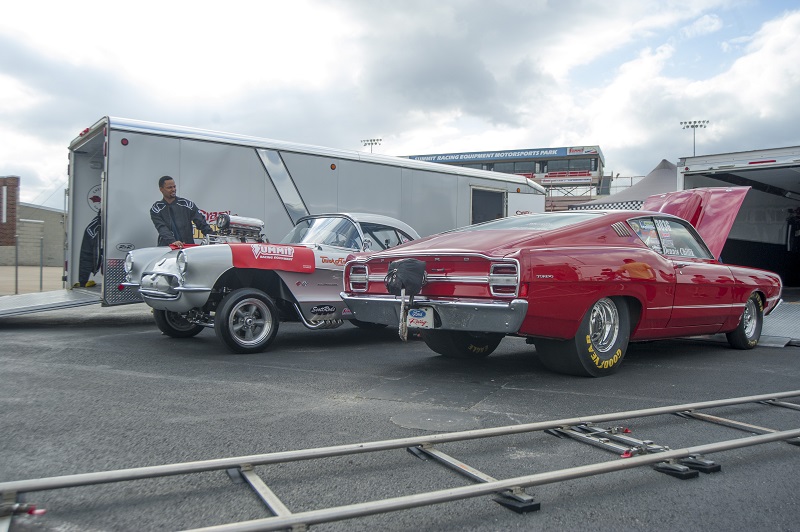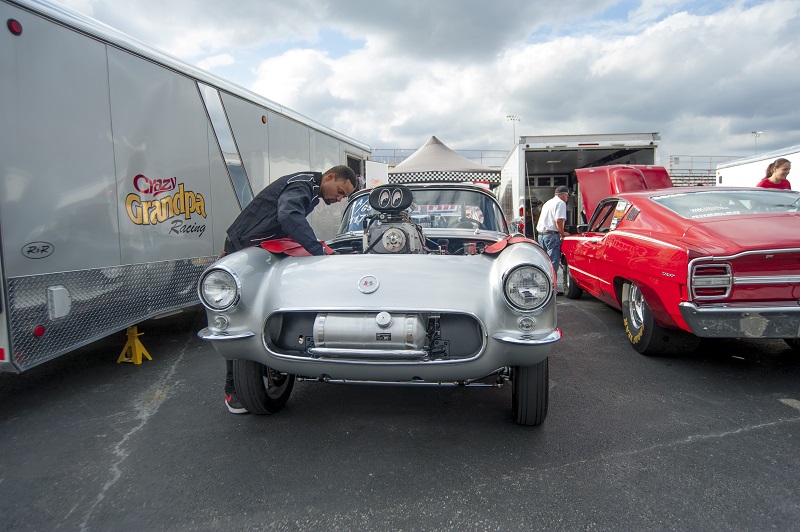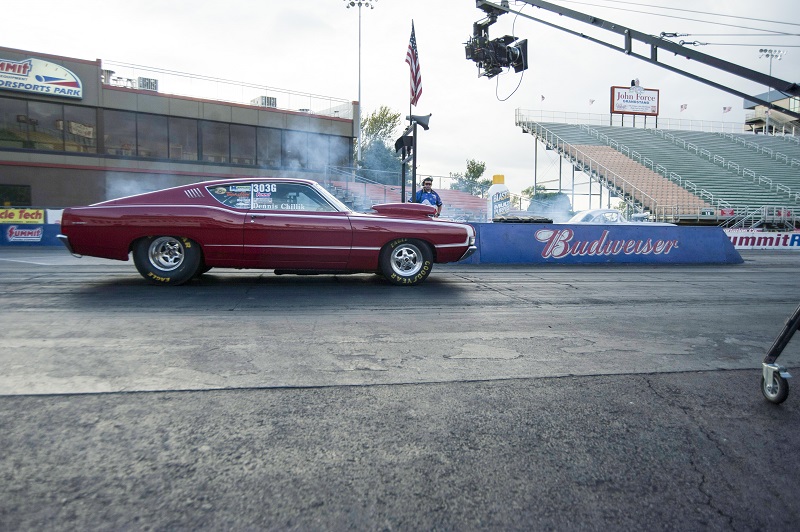
(Image/Summit Racing – Jason Liss)
When Dennis Chillik purchased his first car—a 1968 Ford Torino GT—he couldn’t have imagined that 50 years later he would be piloting it down the quarter-mile in a Summit Racing TV commercial.
Same goes for Bob Cook, who drives his “Crazy Grandpa” 1957 silver Corvette Gasser in the opposing lane in Summit Racing’s ‘Bragging Rights’ TV spot, which ran nationally on networks like Velocity, Discovery, and MavTV, as well well as on Fox Sports during NHRA national event coverage.
“I can’t tell you how many people have told me they’ve seen the commercial,” Cook said. “They run it during the final round of the NHRA events. It’s crazy.”
The commercial was shot in a single day at Summit Motorsports Park in Norwalk, OH. The idea behind the commercial was to capture the spirit of camaraderie and competition that typifies a day at the track.
Cook and Chillik appear briefly at the beginning of the commercial. While actors were used for in-car close-ups, both men drove their cars in the staging lanes and down the track for the actual spot.
For Chillik, a seasoned drag racer accustomed to getting things done quickly from tree to finish line, shooting the commercial ran considerably longer than he anticipated.
“We made four passes,” said Chillik, a New Franklin, OH native. “I originally thought it was going to be just a half an hour, an hour, something like that. I got there first thing in the morning and they started shooting the drag racing around 6 that night. It went all day.”
Cook’s Corvette

(Image/Summit Racing – Jason Liss)
Cook, a retired HVAC contractor and grandfather of three, drag raced during his high school years and got hooked on Gassers about eight years ago.
As a member of ScottRods AA/Gassers, the Chagrin Falls, OH resident goes head to head against other racers devoted to recreating the “Gasser Wars” era, when Willys, Austins, Tri-Five Chevys, Studebakers and other models—called Gassers because they ran on gasoline—ruled the drag strips of the 1950s and ‘60s.
“I had a friend who was already doing this, and he invited me out to a race one day. When I saw what they were doing I said, ‘Man, that looks like fun,’” Cook said.
After he and his wife, Pam, acquired the 1957 Corvette, builders Ed and Ray Kasicki of Shalersville, OH, stripped it of excess weight and modified it with signature features of the classic Gasser, including a straight front axle for maximum weight transfer to the rear slicks, and a narrowed Ford nine-inch axle in the back.
It’s powered by a 1,200 horsepower, 496 cubic-inch big block Chevy engine (built by Gellner Engineering) with a supercharger and Hilborn mechanical fuel injection.
The Corvette rides on Mickey Thompson rubber wrapped around American Racing Torq Thrust wheels. Unlike its 1960s predecessors, Cook’s blown Gasser runs on methanol and is equipped with safety gear that meets NHRA requirements.
Chillik’s Torino

(Image/Summit Racing – Jason Liss)
Chillik and his wife, Carol, special ordered the Torino GT for $3,106 and took delivery of it in June 1968.
The car began its life as the couple’s everyday ride, hauling a camper on weekends, and serving as reliable transport for the Chilliks’ growing family.
By 1977, the Torino had earned a well-deserved rest, hibernating in a garage for 15 years. Upon the urging of his sons, Chillik brought the Torino out of storage for its second life.
“I decided to turn it into a race car,” said Chillik, who retired from Akron, OH-based Goodyear Tire and Rubber Company after 44 years—the last 29 of which were spent building Goodyear race tires.
Repainted to its original candy apple red with white stripes, the Torino is now powered by a 572 big block Ford with Trick Flow 360cc A-460 heads and R-Series intake manifold.
To stay competitive in pro-tree racing (Chillik raced the Torino in the 9.90 index class), the car was equipped with a Rossler Turbo 400 transmission with a nine-inch converter. You can see the Torino’s front wheels leave the ground in the commercial.
The Torino also sports tubular front control arms with coilover shocks and springs; a narrowed Ford nine-inch rear axle with coilover shocks and ladder bars; Strange 4.56 gears and a spool; and 14-inch wide rear wheels with Goodyear slicks.
Being part of the Summit Racing commercial was another milestone in the car’s long journey from daily driver to the dragstrip.
“Not many people are using the car they bought new as a race car 50 years later,” he said.

Comments